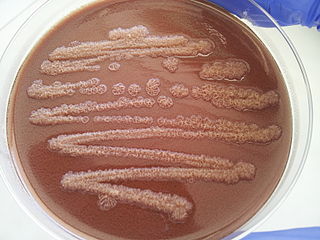
Thermus is a genus of thermophilic bacteria. It is one of several bacteria belonging to the Deinococcota phylum. According to comparative analysis of 16S rRNA, this is one the most ancient group of bacteria Thermus species can be distinguished from other genera in the family Thermaceae as well as all other bacteria by the presence of eight conserved signature indels found in proteins such as adenylate kinase and replicative DNA helicase as well as 14 conserved signature proteins that are exclusively shared by members of this genus.

Halomonadaceae is a family of halophilic Pseudomonadota.
Pseudomonas veronii is a Gram-negative, rod-shaped, fluorescent, motile bacterium isolated from natural springs in France. It may be used for bioremediation of contaminated soils, as it has been shown to degrade a variety of simple aromatic organic compounds. Based on 16S rRNA analysis, P. veronii has been placed in the P. fluorescens group.
Pseudomonas plecoglossicida is a fluorescent, Gram-negative, rod-shaped, motile bacterium that causes hemorrhagic ascites in the ayu fish, from which it derives its name. Based on 16S rRNA analysis, P. plecoglossicida has been placed in the P. putida group.

Pseudomonas stutzeri is a Gram-negative soil bacterium that is motile, has a single polar flagellum, and is classified as bacillus, or rod-shaped. While this bacterium was first isolated from human spinal fluid, it has since been found in many different environments due to its various characteristics and metabolic capabilities. P. stutzeri is an opportunistic pathogen in clinical settings, although infections are rare. Based on 16S rRNA analysis, this bacterium has been placed in the P. stutzeri group, to which it lends its name.
Hydrogenophaga is a genus of comamonad bacteria, several of which were formerly classified in the genus Pseudomonas.

Delftia is a genus of Gram-negative bacteria that was first isolated from soil in Delft, Netherlands. The species is named after both the city, and in honor of pioneering research in the field of bacteriology that occurred in Delft. Cells in the genus Delftia are rod shaped and straight or slightly curved. Cells occur singly or in pairs, are 0.4–0.8ɥM wide and 2.5–4.1 μm long. Delftia species are motile by flagella, nonsporulating, and chemo-organotrophic.
Devosia riboflavina is a Gram-negative soil bacterium. The species Pseudomonas riboflavina was transfer to Devosia riboflavina

The genus Alishewanella is one of the major branches of the family Alteromonadaceae. It was proposed to accommodate A. fetalis, isolated from an autopsy of a human fetus, in 2000. In 2009, A. aestuarii was isolated from tidal flat sediment and indicated as being a representative of Alishewanella. The third Alishewanella species was isolated from gajami sikhae, a Korean fermented food, in 2009 and was given the name A. jeotgali. Most recently, in 2010, the fourth currently isolated species of Alishewanella, A. agri, was isolated from landfill soil in Korea. Currently these are the only four isolated and characterized species of the genus Alishewanella.
Cupriavidus gilardii is a Gram-negative, aerobic, motile, oxidase-positive bacterium from the genus Cupriavidus and the family Burkholderiaceae. It is motil by a single polar flagellum. It is named after G. L. Gilardi, an American microbiologist. The organism was initially identified as Ralstonia gilardii in 1999, renamed Wautersiella gilardii, and most recently moved into the genus Cupriavidus after 16S rRNA gene sequencing revealed it to be most closely related to Cupriavidus necator. Notably, species of this genus are not inhibited by copper due to the production of chelation factors, and may actually be stimulated by the presence of copper.
Aminobacter aganoensis is a bacterium from the genus of Aminobacter which was isolated from soil.
Aminobacter niigataensis is a bacterium from the genus of Aminobacter which was isolated from soil.
Gracilibacillus is a genus of bacteria within the phylum Bacillota. Species within this genus are generally halotolerant.
Bacteriovorax is a genus containing a single species of bacterium in the family Bacteriovoracaceae, Bacteriovorax stolpii. It is a predator that feeds on larger Gram-negative bacteria. These prey bacteria tend to live in enteric environments and have similar lipopolysaccharide structures. Bacteriovorax stolpii recognizes its prey by outer membrane protein receptors, which explains why Gram-positive bacteria that lack outer membranes do not serve as prey. They prey on bacteria by invading the interperiplasmic space where they feed, grow, and reproduce. Bacteriovorax stolpii used to be classified in the genus Bdellovibrio because of similar morphologies and lifestyle characteristics, however they were recognized as a new genus through phylogenetic analysis.
Prosthecomicrobium pneumaticum is an aerobic bacterium from the genus of Prosthecomicrobium which has been isolated from freshwater.
Robert S. Dickey was an American phytopathologist, professor emeritus of Plant Pathology at the Cornell University and the namesake of the bacterial genus Dickeya.
Microbacterium hominis is a bacterium from the genus Microbacterium which has been isolated from lung aspirate.
Xenophilus azovorans is a bacterium from the genus Xenophilus which has been isolated from soil in Switzerland.
Sphingobacterium olei is a Gram-stain-negative, rod-shaped, and non-motile bacterium. It was first isolated from oil-contaminated soil in Daqing oil field, China. S. olei has been found to be able to degrade herbicides quizalofop-p-ethyl and diclofop-methyl. Before a name was given, S. olei was designated as strain HAL-9T. The species name olei means "of oil" in Latin.
Alkalihalobacillus is a genus of gram-positive or gram-variable rod-shaped bacteria in the family Bacillaceae from the order Bacillales. The type species of this genus is Alkalihalobacillus alcalophilus.




